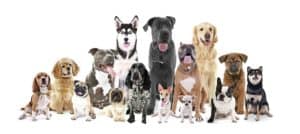
One of my favorite things is petting Pica, the dog pal who lives down the road from me. As my hand sinks into her coat, she sits on her back legs and gives me a loving Husky greeting. Apart from the big wet kiss, I notice how good she smells.
It gets me thinking, how much can you tell from looking at a dog’s fur?
Dog fur works just like human hair, in that it’s made up mainly of a fibrous protein called keratin, the stuff that also makes up our nails, and also claws, horns, hooves, feathers and more.
Hair grows from follicles, little sacs in the skin. The difference between dogs and humans is that we grow one hair per follicle whereas dogs can grow several.
Again, both human and dog skin have little oil glands that keep skin and hair soft.
In the canine world, dogs that have been bred to work in water will have super active oil glands that help them maintain a waterproof coat. So, if you’re heading for shampoo that deals with oily hair, you might say you have the hair of a Retriever!
However, many dogs have rather more complex hair structures than us.
Pica, my Husky pal, for example has an undercoat of really soft fluffy hair that keeps her warm, and a top coat of stiff or guard hairs that help her keep dry. This so-called double coat is designed especially for her native climate, the frostier parts of Canada and Russia.
The Gremlins next door are Silky Terriers that were bred for warmer climates. Therefore, they have no undercoat but they do have a long, soft, top coat. It is also oily which makes them super shiny but also means they need a lot of brushing.
Interestingly, dogs that have a single layer are said to have hair while dogs that have a double coat are said to have fur.
While dogs have different fur textures, like the wire-haired dachshund, feathery Shih Tzu, and woolly Poodle, healthy coats all look attractive and feel good when you run your hands over them.
If you don’t get a good look or it doesn’t feel right, it pays to consider why.
Healthy hair is made up mostly of keratin, living cells that are produced by the body and pushed out from the skin. As the cells grow out, they die and form a layer around the younger cells beneath. If the keratin is damaged, you can get fur that feels dry or rough to the touch.
If your dog seems otherwise perfectly healthy and happy, first take a look at your grooming rituals. Are you using a shampoo that is too harsh? Or perhaps towel-drying to roughly? Or using a blast of heat to style your pet’s coat?
If you think this is the issue, then consider skipping a few baths and go in for some soft brushing instead. And change the way you groom your pet.
If your dog has a difficult coat, speak to a professional groomer for special tips.
As we live in the tropics, pets who spend time sunning may pick up natural highlights. It’s super pretty but it can also lead to dry hair and split ends. So if you have a sunbather, consider that you may need to add a conditioner to your grooming ritual.
Also, keep an eye on ears and noses. Like us, dogs can get sunburned. If it peels, you may get infections.
And there’s also the possibility that long-term damage may lead to skin cancer. If you’re concerned, talk to your vet.
As hair is produced by the body, there’s a lot of sense to the old adage what you eat is going to affect how you look. While quality commercial dog food is created to give your pet an array of vitamins and minerals needed to keep healthy, some dogs have their own special challenges.
If your pet is elderly, has tummy troubles or allergies, or is a picky eater, you may need to add in some extra vitamins.
The ones that are directly linked to a dull or problem coat include biotin, vitamin A, zinc, copper and selenium.
Supplements can be useful; however, overdosing can be a big risk. As too many vitamins can lead to serious and fatal health issues including kidney damage, always consult your vet first.
What you can do is to swap out the occasional commercial food for a bowl of chopped red meat, sardines or tuna, with a sprinkling of carrots. This simple dish provides a good vitamin punch and it’s a pawsome treat as well.
If you see your pet’s coat is dull and the skin is also irritated, first ask yourself when you last dewormed and pest-proofed your pet.
Tummy worms can cause all kinds of health issues including a poor coat. In addition, tiny pests on the skin like mites and fleas can cause skin irritation and that will lead to coat issues.
To keep your pet healthy, be sure to keep to a regular deworming schedule and use proper flea and mite products.
Like us humans, dogs sometimes develop other health conditions that cause dull fur and itchy skin like thyroid imbalance, hormone issues and canine psoriasis, a skin disorder that results in a super itchy scaly rash.
Luckily, most can be put right but it does take diagnosis and proper treatment.
So if basic care doesn’t make a difference, or you also see your pet being depressed, low in energy or otherwise not quite right, go and see your vet.
